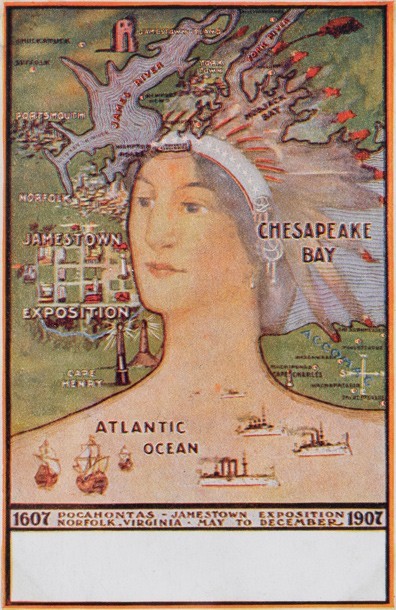
Souvenir postcard, United States, 1906. Cardstock. 3 1/2 x 5 1/2". (Unless otherwise indicated, all objects in author’s collection and all photos by Gavin Ashworth.) Stylized map of the exposition site, Virginia Capes, Jamestown Island, etc. in which the head and headdress of Pocahontas conform to the Chesapeake Bay and its tributaries. Note the unusual orientation, with west at the top.
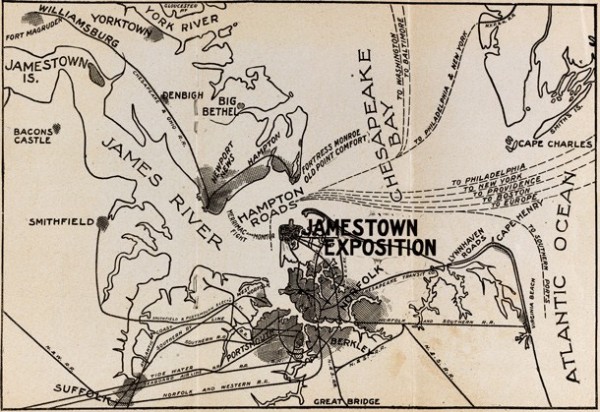
Back page of trifold Jamestown Tercentennial Exposition promotional pamphlet, United States, 1906. Paper. 9 1/2x 12". Less attractive but more functional than the image illustrated in fig. 1, this map provides considerably more detail, including the locations of Fort Monroe and the site of the legendary Monitor-Merrimack engagement as well as railroad and steamship routes.
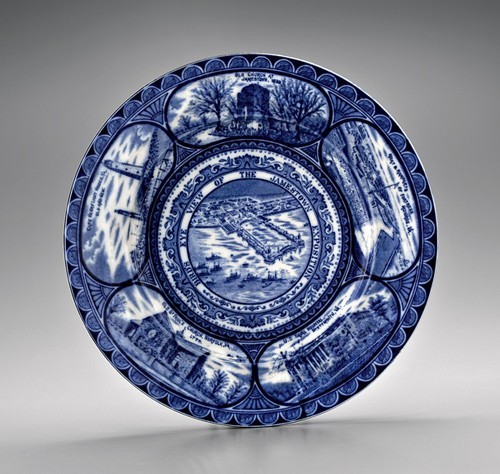
Dinner plate, StaVordshire, England, ca. 1907. Whiteware. D. 10 1/8". Transfer-printed souvenir plate with central motif of bird’s-eye view of the government piers at the Jamestown Tercentennial Exposition surrounded by cartouches of St. Paul’s Church in Norfolk, Cape Henry lighthouses, the church tower at Jamestown, Fort Monroe, and the U.S. Naval Hospital in Portsmouth.
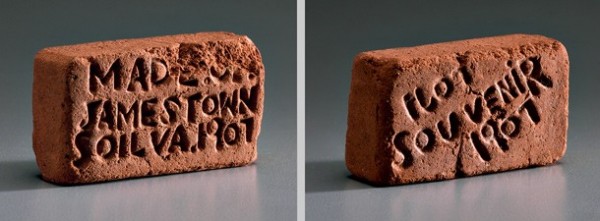
Miniature brick, United States, ca. 1907. Earthenware. L. 2". Marks: impressed on front, “MADE OF / JAMESTOWN / SOIL VA. 1907”; impressed on back, “1607 / SOUVENIR / 1907.”
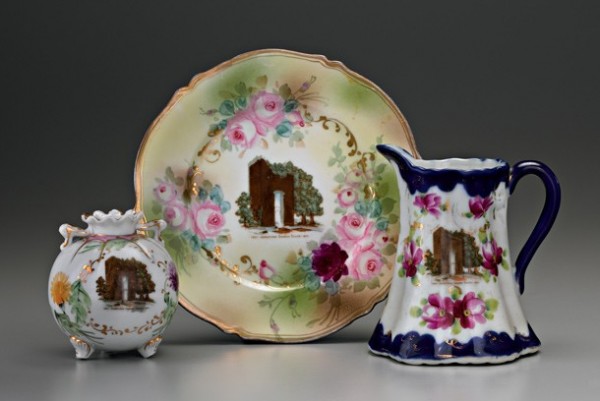
Globular vase, pitcher, and plate, United States or England, ca. 1907. Porcelain. D. of plate 7 1/2".

(Left to right) Pipe bowl with reed stem, probably United States, 1906, earthenware. Toothpick holder, probably United States, ca. 1907, porcelain. Miniature stein with pewter lid, Germany, ca. 1907, stoneware, H. 3 1/4".

Dessert plate, A. C. Bosselman Company, New York, ca. 1907. Porcelain. D. 6 1/2".
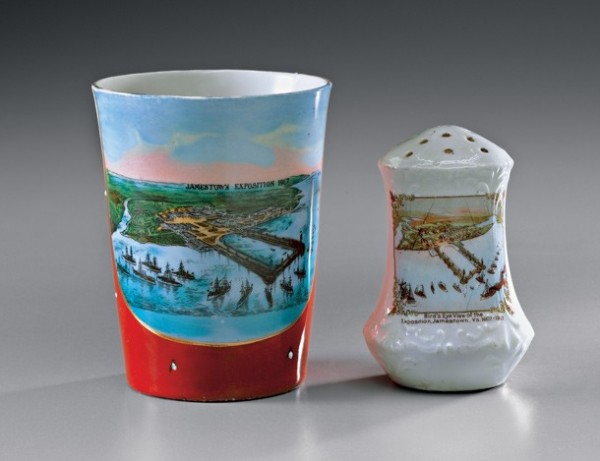
Beaker, A. C. Bosselman Company, New York, ca. 1907. Porcelain. H. 3 3/4". Pepper shaker, United States, ca. 1907. Porcelain. H. 3 1/8".

Stereoview picture of the Martin Gillette and Company’s exhibit at the Jamestown Expo’s Pure Food and Drug Building, with caption boasting “The biggest tea-pot on earth, holding a million cups,—Pure Food Exhibit, Jamestown, Va.” (Courtesy of the Hampton Roads Naval Museum.)
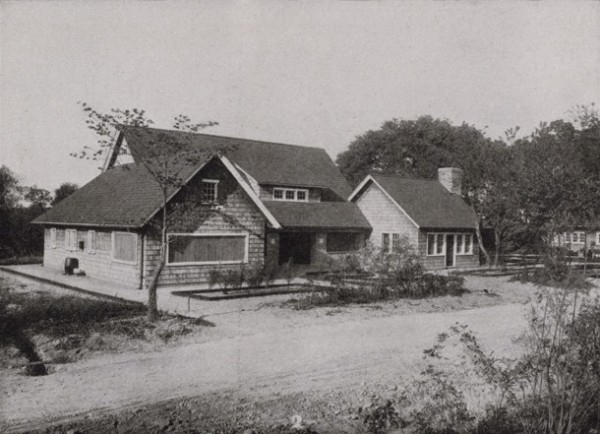
The Pottery Building at the Jamestown Exposition, reproduced in Glimpses of the Jamestown Exposition and Picturesque Virginia (Chicago: Laird and Lee, 1907), unpaginated.
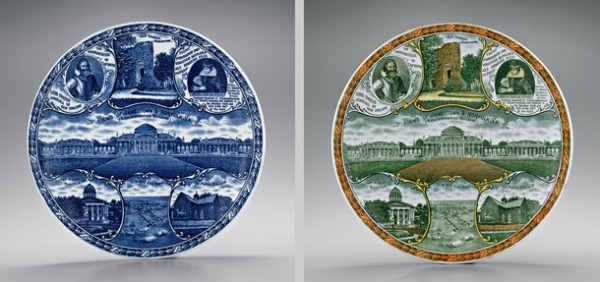
Pair of dinner plates, Staffordshire, England, ca. 1907. Whiteware. D. 10".
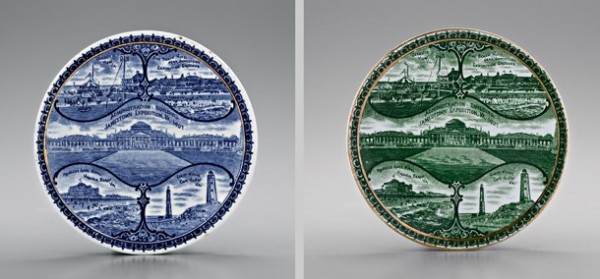
Pair of dessert plates, Staffordshire, England, 1906. Whiteware. D. 6".

Dessert plate, probably England, ca. 1907. Porcelain. D. 7 1/2". Note the similarity of the border decoration to that of the plate illustrated in fig. 5.
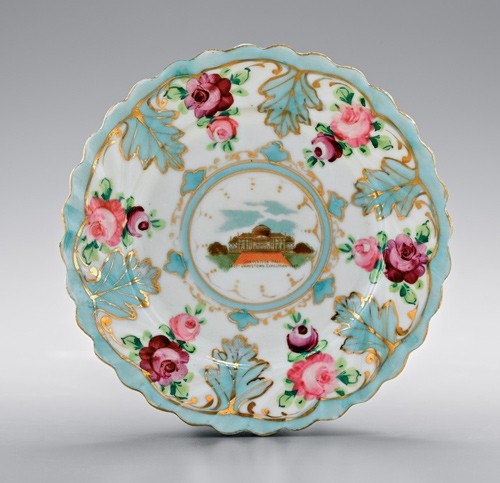
Saucer, probably England, ca. 1907. Porcelain. D. 6".
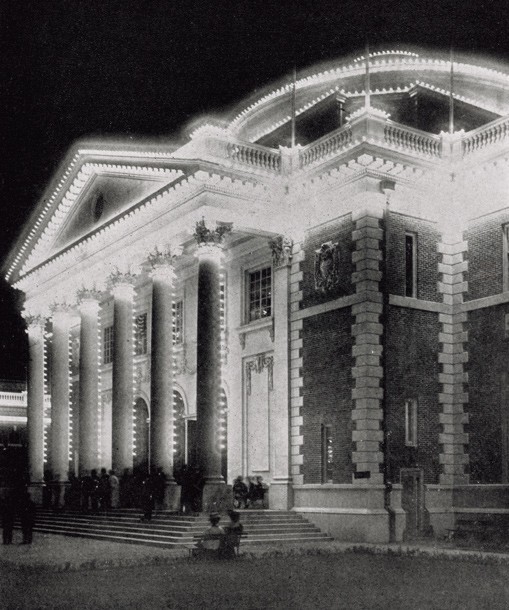
“Night illumination” of the Administration Building. Photo, reproduced from Illustrated Souvenir of the Jamestown Ter-Centennial Exposition (Norfolk, Va.: Seaboard Publishing Company, 1907), unpaginated.
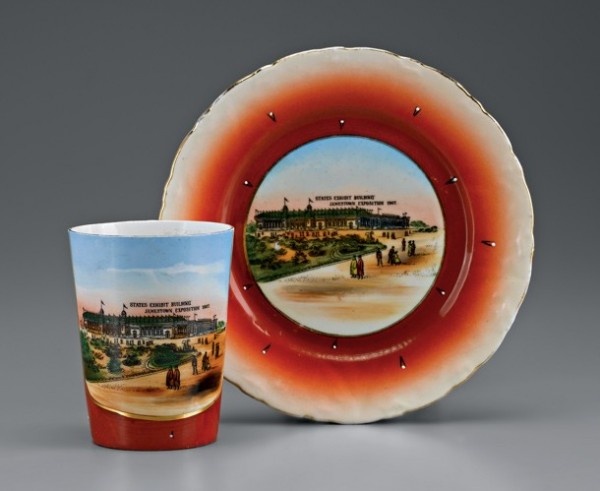
Dessert plate and beaker, A. C. Bosselman Company, New York, ca. 1907. Porcelain. D. of plate 6 3/4".
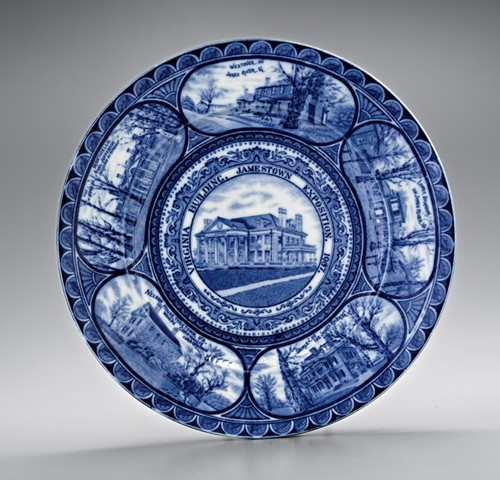
Plate, Royal Staffordshire Pottery, Burslem, England, ca. 1907. Whiteware. D. 10". This transfer-printed souvenir plate has a central motif of the Virginia Building surrounded by oblong cartouches depicting Virginia historic mansions.
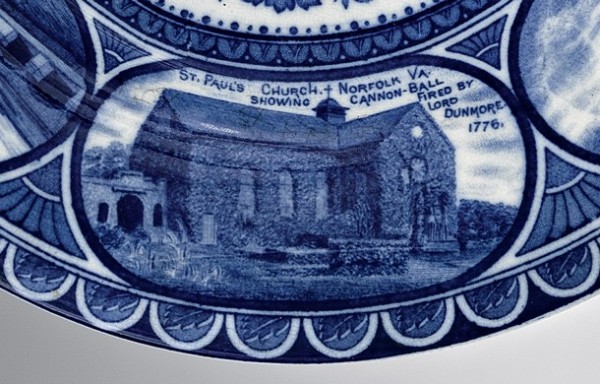
Detail of the plate illustrated in fig. 22 (left), showing the inscription "ST. PAUL'S CHURCH, NORFOLK VA / SHOWING CANNON-BALL / FIRED BY / LORD / DUNMORE / 1776."

Dessert plates, Staffordshire, England, ca. 1907. Whiteware. D. 6 1/2". The central motif on these plates is the seal for the State of Virginia.
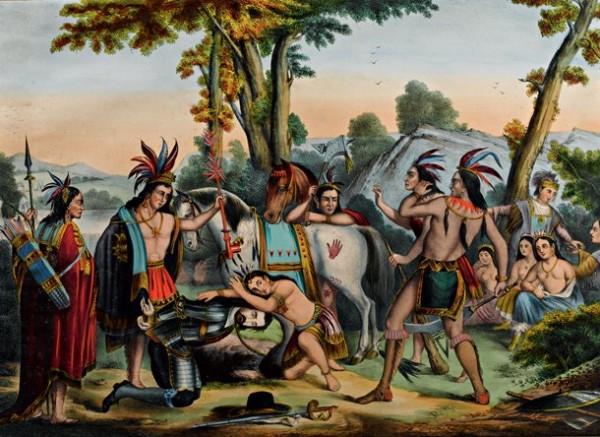
Print, United States, 1874. Paper. 23 3/4 x 29 1/2". By H. Schile of New York after a painting by Edward Henry Corbould.

Plate, Coshocton, Ohio, 1905. Tin. D. 10". The plate probably was made by either J. F. Meeks Tuscarora Advertising Company or H. D. Beach’s Standard Advertising Company.
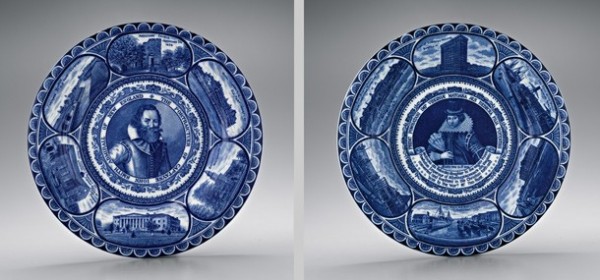
Pair of plates, Rowland and Marsellus Company, Staffordshire, England, 1906. Whiteware. D. 10". One plate has a transfer-printed portrait of Pocahontas as the central motif, the other has John Smith, both with surrounding cartouches. The legend of the Pocahontas plate includes both her given name, Matoaka, and the one she received after baptism, “Rebecka” or Rebecca. Produced for the S. T. Hanger Company of Portsmouth, Virginia.
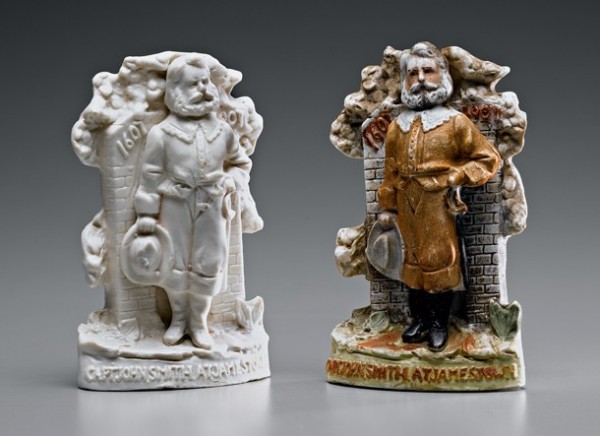
Pair of bud vases, United States, ca. 1907. Bisque porcelain. H. 4 7/8". Figural bud vases of John Smith in both unpainted and cold-painted enameled states.

A Pocahontas bud vase. (Photo, courtesy Hampton Roads Naval Museum.)

The Persimmon or John Smith Plate, Edwin Bennett Pottery, Baltimore, Maryland, 1906. Whiteware. D. 9 1/2". (Courtesy, Collection of Ken Beem; photo, Ken Beem.)
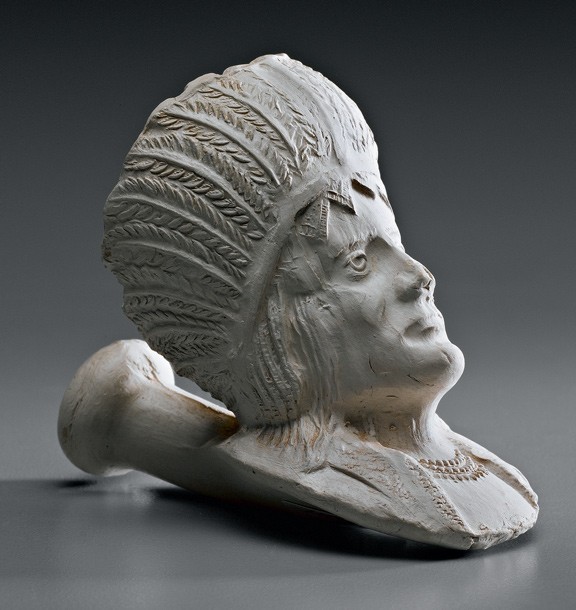
Pipe bowl, United States, ca. 1907. Unglazed earthenware. H. 2 1/4". This pipe bowl has been molded in the image of Chief Powhatan.
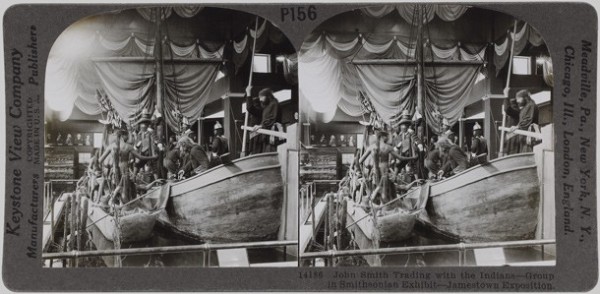
Stereoview card, United States, ca. 1907. Photo mounted on cardboard, 3 1/2 x 7".
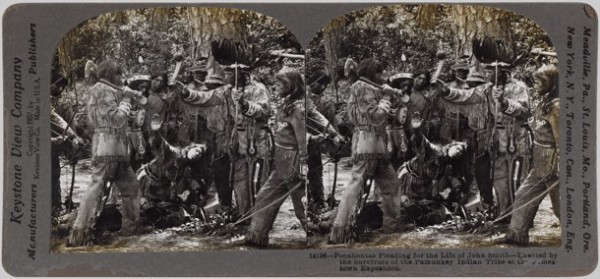
Stereoview card, United States, ca. 1907. Photo mounted on cardboard, 3 1/2 x 7".
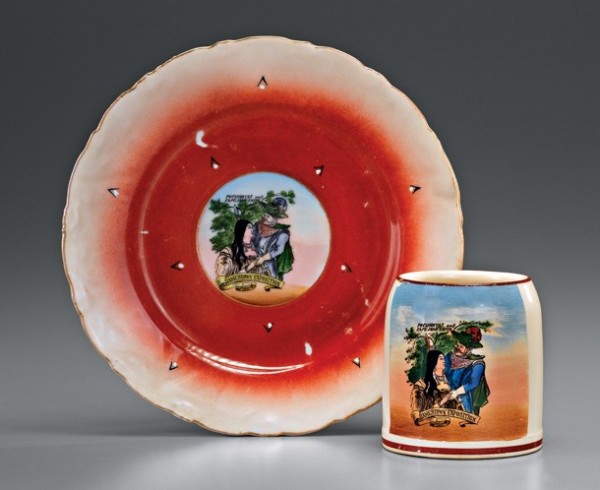
Dessert plate and mug, A. C. Bosselman Company, New York, ca. 1907. Porcelain (plate) and earthenware (mug). D. of plate 6 1/2".
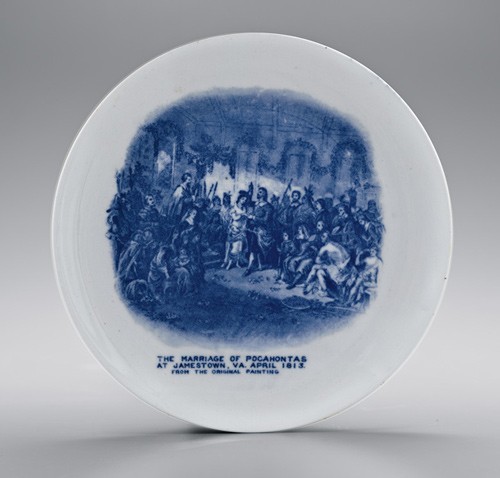
Dessert plate, United States, 1907. Whiteware. D. 7 3/4". Transfer-printed image of the marriage of Pocahontas and John Rolfe, after an 1855 oil painting by Henry Brueckner.
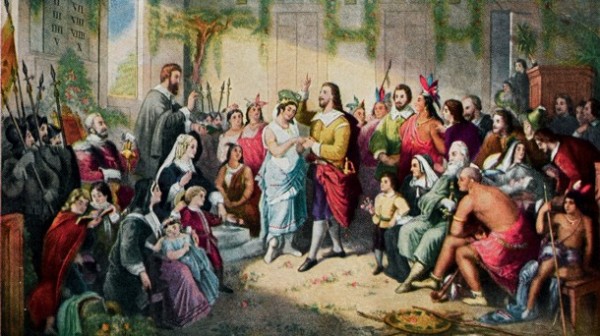
Postcard, “Marriage of Pocahantas,” United States, 1907. Cardstock. 3 1/2 x 5 1/2".
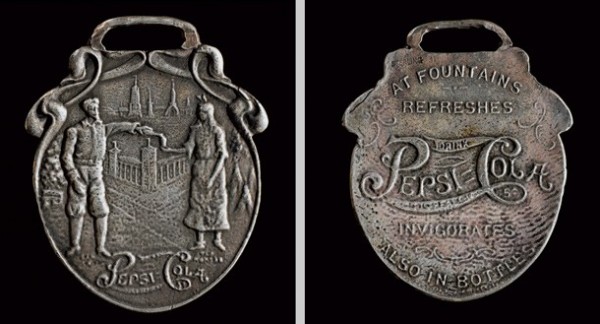
Watch fob, United States, ca. 1907. Silver. 1 1/2 x 1 5/8".
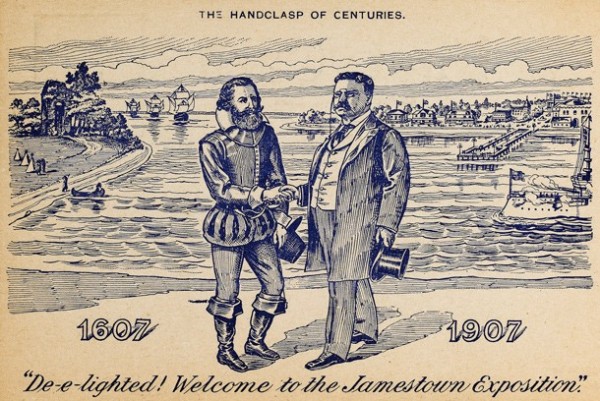
Postcard depicting “The Handclasp of Centuries,” United States, 1907. Cardstock. 3 1/2x 5 1/2".
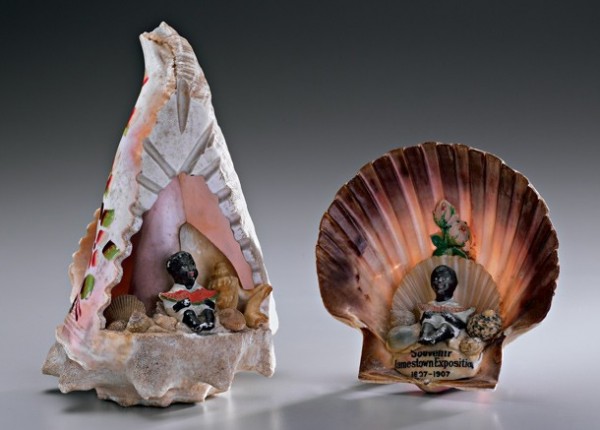
Dioramas, probably United States, ca. 1907. Shell and bisque. H. of larger diorama 6 1/4".
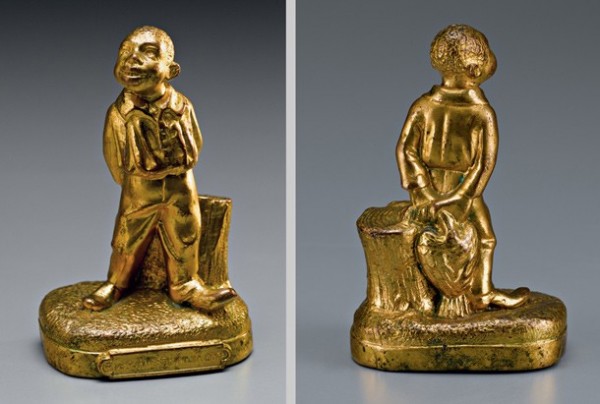
Figure, probably United States, ca. 1907. Gilt base metal. H. 3 3/4".
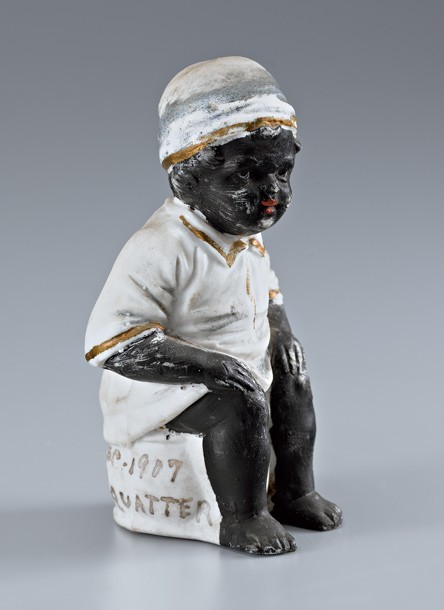
Figure, United States or Germany, ca. 1907. Bisque porcelain. H. 4 1/8". Press-molded, inscribed in ink: “1607 May – A – Dec - 1907 / Jamestown Squatter.”

Detail of the inscription on the base of the figure illustrated in fig. 36.
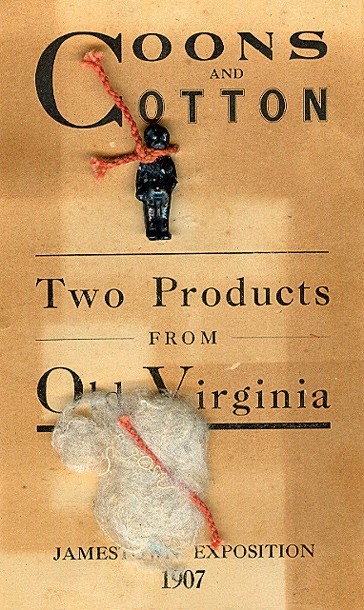
Postcard, United States, 1907. Cardstock, bisque, and cotton. 3 1/2 x 5 1/2". (Collection of Sally Carver; photo, Sally Carver.) Label: “COONS AND COTTON / Two Products / FROM / Old Virginia / JAMESTOWN EXPOSITION / 1907.”
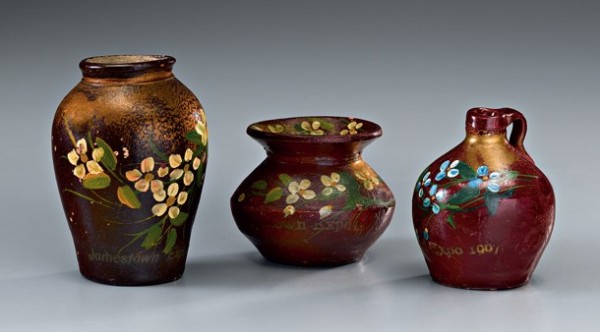
Miniature crock, urn, and jug, United States, ca. 1907. Red-glazed and enameled-painted earthenware. H. of crock 3 1/4".
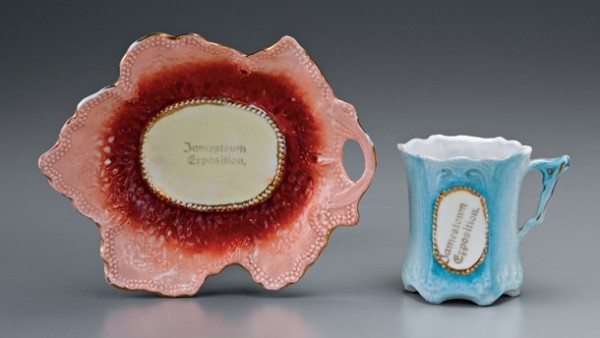
Cup and tray, Germany, ca. 1907. Porcelain. H. of cup 3".

Trifold postcard, Raphael Tuck & Sons, England, ca. 1907. Cardstock. 3 1/2 x 16 1/2". Entitled “Shore Promenade,” this postcard depicts a beautifully romanticized view of the fair, one that contrasts the genteel women in their late Victorian finery on one side with modern warships and steam yachts on the other.

Shoe, America or Europe, ca. 1907. Porcelain with gilt accents. H. 2 1/2".

Figurines, Germany, ca. 1907. Porcelain. H. of tallest 3". Three piglets: one next to a bucket, another in a bag with a coin slot on top, and the third in a basket. The first two are labeled “Souvenir of Jamestown Exposition 1907,” the third simply “Jamestown Exposition 1907”; all with “Made in Germany” base stamp.
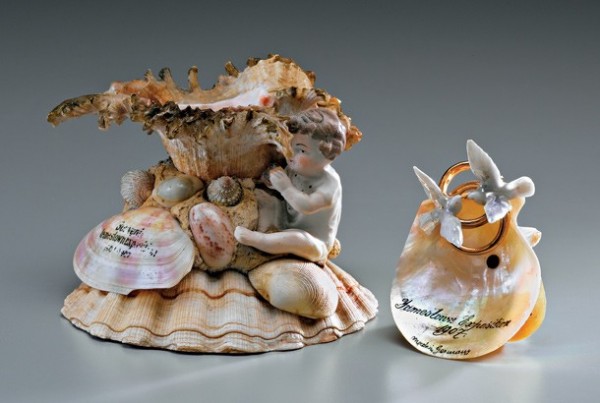
Montage, possibly United States, ca. 1907. Bisque and shell. H. 3 1/2". Labeled “Souvenir Jamestown Exposition 1607–1907.” H. of bisque figure 2 1/8". Ring holder, Germany, ca. 1907. Porcelain and shells. H. 1 7/8". Labeled “Jamestown Exposition / 1907 / Made in Germany.”
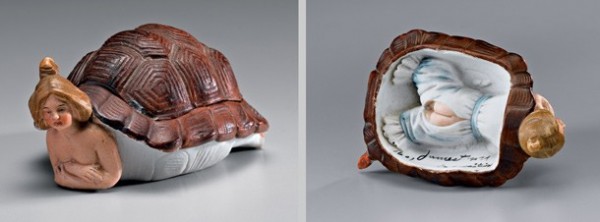
Figural box, United States or Germany, ca. 1907. Porcelain. L. 4 1/4", H. 2Q÷@". Hand-inscribed in ink, “1607 Jamestown Exposition 1907.”

Plaque, United States, ca. 1907. Bronze. 2 3/8 x 3 1/8". (Courtesy, Collection of Dan Carr; photo, Dan Carr.) Obverse of plaque commemorating the departure of the Great White Fleet from Hampton Roads barely two weeks after the closing of the Jamestown exposition. Designed by U.S. Mint sculptor Charles Barber. A profile bust of Theodore Roosevelt, designed by U.S. Mint sculptor George Morgan, is depicted on the reverse.
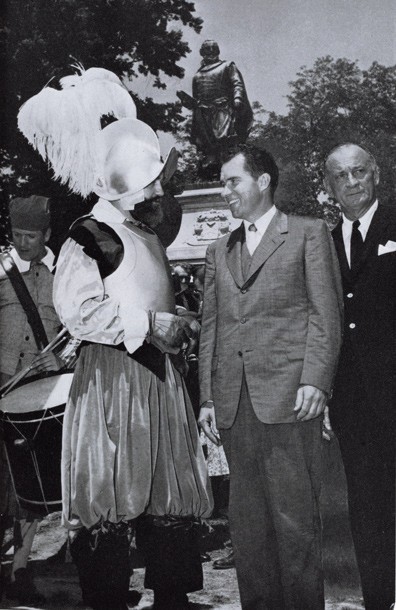
Unable to attend the Jamestown Festival of 1957 himself, President Dwight D. Eisenhower sent Vice President Richard M. Nixon in his stead. In a photo oddly reminiscent of “The Handclasp of Centuries” (see fig. 33), Nixon poses with the costumed actor portraying John Smith (illustrated in 350th Anniversary, p. 27).
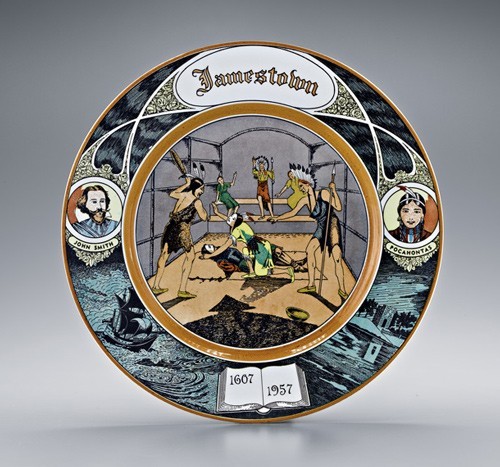
Plate, Conrad Crafters Wheeling, Inc., West Virginia, 1955. Whiteware. D. 10". This example is dated “Dec. 2, 1955” and features a design taken from the 1907 Vienna Art Plate. Similar plates were produced by the Homer Laughlin Company.
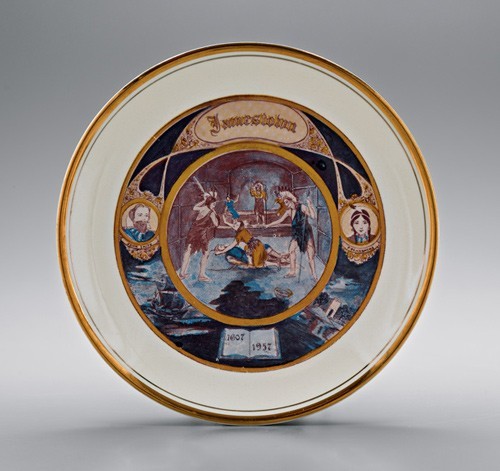
Dessert plate, Colonial China Company, South Hill, Virginia. Jamestown Souvenirs Newport News, Virginia, 1956. Whiteware. D. 7 1/2".
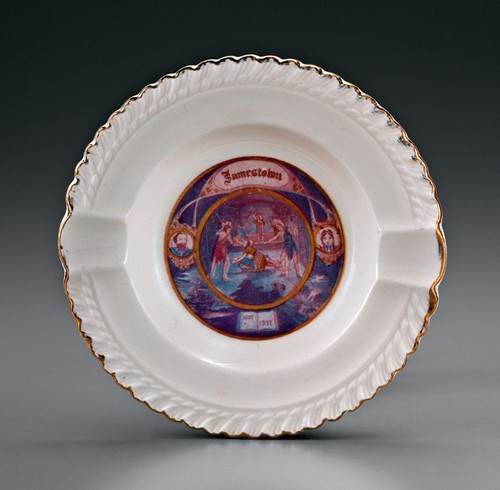
Ashtray, Colonial China Company. South Hill, Virginia, 1955. Whiteware. D. 5 1/2". Virginia copyright 1955 also featuring 1907 Vienna Art Plate design.

Ashtray, United States, ca. 1957. Whiteware. D. 6 1/8". Unmarked on the base but with attached sticker from the Williamsburg Pottery, a long-standing discount shopping mecca for area locals and tourists in Lightfoot, Virginia.

Tile, Germany, ca. 1957. Earthenware. 6 1/2" square. Mark: on back, “Made in Germany Danischburg”
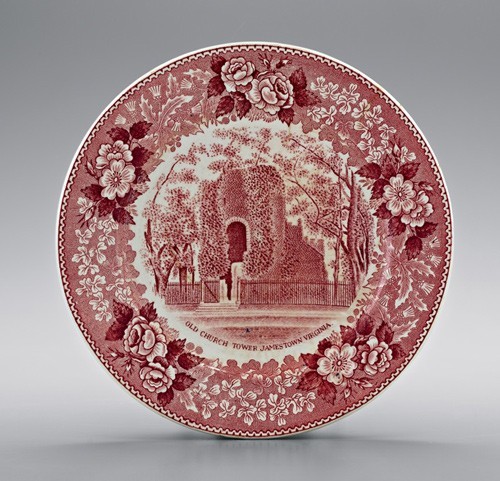
Dessert plate, Adams, England, ca. 1957. Whiteware. D. 6 3/4". Produced for the APVA on the “350th Anniversary of the Founding of the Nation, 1607–1957.” The plate was also produced in blue.
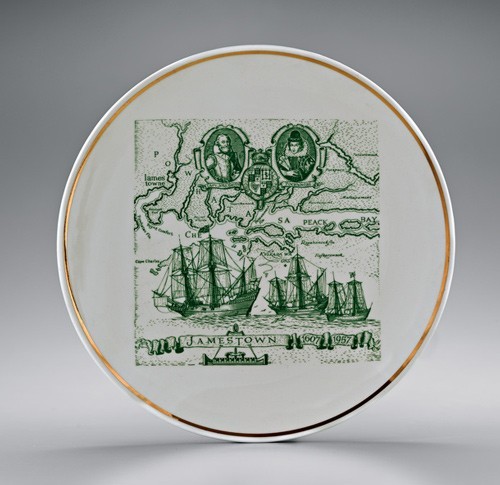
Dinner plate, Conrad Crafters Wheeling, Inc., West Virginia, ca. 1957. Whiteware. D. 9 5/16". The plate was also produced with brown and black transfer prints.
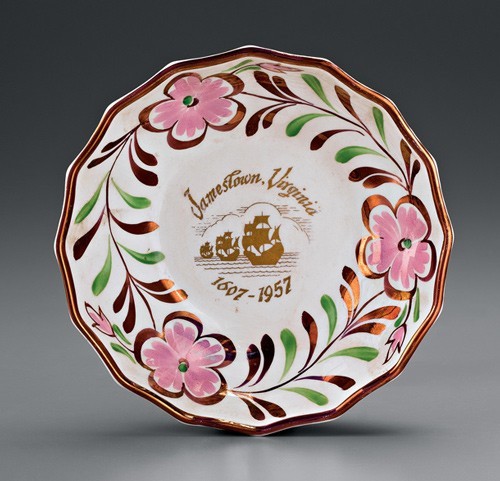
Dish, Gray’s Pottery, Stoke-on-Trent, England, ca. 1957. Whiteware. D. 5 5/8".

Dinner plate, Royal China Inc., Sebring, Ohio, ca. 1957. Whiteware. D. 9 7/8". The plate bears a transfer print of “Fort James” (James Fort) and a moored vessel surrounded by an English ivy border.
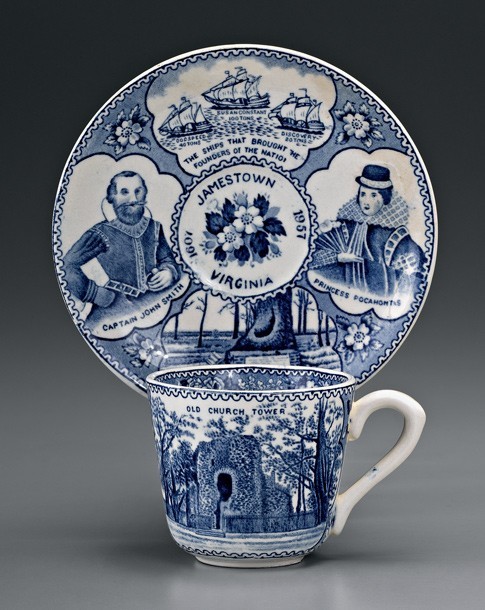
Cup and saucer, Adams, England, ca. 1957. Whiteware. D. of saucer 4 7/8". This dainty cup and saucer are perhaps unique among the 1957 ceramic souvenirs in incorporating all the popular images—church tower, Smith and Pocahontas, expedition ships, James Fort—and the Blair tomb on Jamestown Island to boot. Printed on the other side of the cup is an image of James Fort.
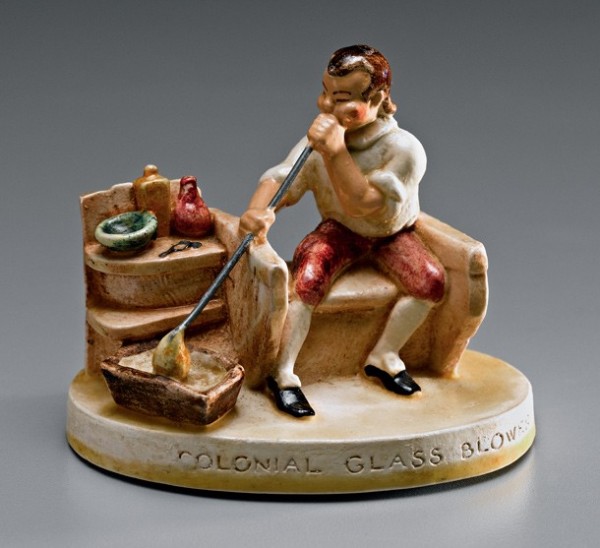
Figurine, American, 1957. Bisque porcelain. H. 2 5/8". Marks: inscribed on rim, “COLONIAL GLASS BLOWER”; base sticker, “A Sebastian miniature designed by Prescott W. Baston Marblehead Mass.” and “COPR 1957 P. W. Baston” impressed on back. Baston and his colleagues visited the festival park in 1957 and struck a deal with the gift shop to produce a series of four miniatures that also included the church, the fort, and the three ships.
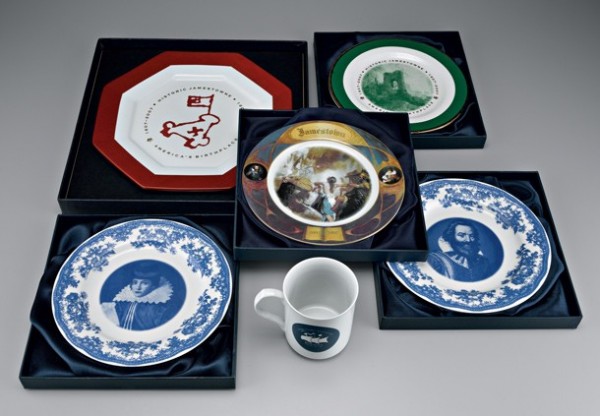
Plates and mug, United States, 2007. Whiteware and porcelain. D. of largest plate 10 1/2". Ceramics from Jamestown 2007 generally represent slight stylistic variations of earlier motifs: the church tower; portraits of Pocahontas and John Smith; the expedition ships; and the 1907 Vienna Art Plate. The design of the fort plate (upper left), taken from a tracing of a 1608 John Smith map of Virginia sent to Philip III of Spain by his ambassador Pedro de Zuñiga, embodies one of the few innovations. Note that the version of the rescue scene on the 2007 plate (center) is essentially the same as the one employed on the 1957 German tile (see fig. 52). The mug displays the tri-sail logo of the 2007 celebration.
